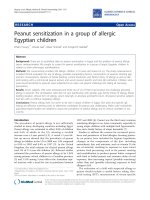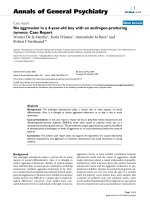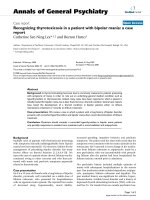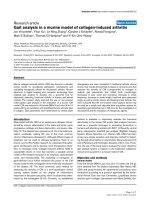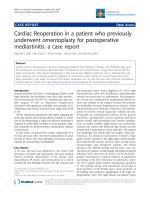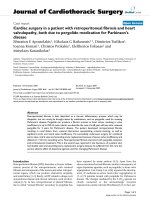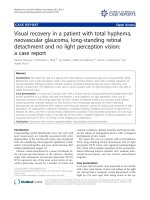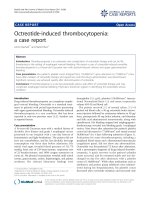Báo cáo y học: " Carcinomatous meningitis in a patient with Her2/neu expressing bladder cancer following trastuzumab and chemotherapy: a case report and review of the literature" ppt
Bạn đang xem bản rút gọn của tài liệu. Xem và tải ngay bản đầy đủ của tài liệu tại đây (821.86 KB, 4 trang )
Case report
Open Access
Carcinomatous meningitis in a patient with Her2/neu expressing
bladder cancer following trastuzumab and chemotherapy: a case
report and review of the literature
Oscar B Goodman Jr
1
, Matthew I Milowsky
2
, Jodi Kaplan
2
, Maha Hussain
3
and David M Nanus
2
*
Addresses:
1
Division of Clinical Oncology, Nevada Cancer Institute, Las Vegas, NV 89135, USA
2
Division of Hematology and Medical Oncology, Department of Medicine, Weill Medical College of Cornell University – New York Presbyterian
Hospital, New York, NY 10021, USA
3
Division of Hematology and Medical Oncology, Department of Medicine, University of Michigan, Ann Arbor, MI 48109, USA
Email: DMN* -
* Corresponding author
Received: 18 August 2008 Accepted: 8 April 2009 Published: 15 September 2009
Journal of Medical Case Reports 2009, 3:9110 doi: 10.4076/1752-1947-3-9110
This article is available from: />© 2009 Goodman Jr et al.; licensee Cases Network Ltd.
This is an Open Access article distributed under the terms of the Creative Commons Attribution License (
/>which permits unrestricted use, distribution, and reproduction in any medium, provided the original work is properly cited.
Abstract
Introduction: Targeted therapies may impact the natural history of bladder cancer based upon their
pharmacokinetics. The Her2/neu receptor tyrosine kinase, overexpressed by half of all primary
urothelial carcinomas, has recently been examined as a therapeutic target in bladder cancer in a
prospective phase II multicenter trial (NCI-198) that enrolled 109 patients with advanced bladder
carcinomas for treatment with trastuzumab in combination with paclitaxel, carboplatin, and
gemcitabine. We report on documented isolated Her2/neu positive carcinomatous meningitis in a
patient treated with trastuzumab.
Case presentation: A 61-year-old Caucasian man with metastatic bladder cancer was treated
with neoadjuvant chemotherapy in combination with trastuzumab with a partial response that was
followed by a complete response after surgery. He relapsed with isolated Her2/neu positive
carcinomatous meningitis.
Conclusion: Carcinomatous meningitis in bladder cancer is extremely rare. This is the first case
reported of Her2/neu positive carcinomatous meningitis. Disease recurred solely at a sanctuary site,
demonstrating that despite the systemic efficacy of trastuzumab in combination with chemotherapy,
its inability to enter the central nervous system potentially contributes to the unusual site of disease
recurrence.
Introduction
The Her2/neu receptor tyrosine kinase is overexpressed by
the majority of all primary invasive urothelial carcinomas
[1]. The epidermal growth factor receptor (EGFR) tyrosine
kinase family comprises four members (erbB-1 through
erbB-4), with erbB-1 (EGFR) and erbB-2 (Her2/neu)
expressed in urothelial carcinoma [2]. Following ligand
activation, the receptors dimerize resulting in stimulation
of multiple signaling pathways, leading to increased cell
growth and survival [3]. Her2/neu-mediated signaling
Page 1 of 4
(page number not for citation purposes)
activates important oncogenic signaling cascades such as
the ras-mitogen activated protein (MAP)-kinase pathway,
phospholipase C-gamma (PLC-g) and phosphatidylino-
sitol-3 (PI-3) kinase [4]. Overexpression of Her2/neu is
associated with higher tumor grade and decreased disease-
related survival [5], suggesting a specific role for Her2/neu
in bladder cancer progression. Gene amplification is rarely
observed, in contrast to breast cancer where gene
amplification is seen in about 25% of cases and correlates
with Her2/neu protein overexpression [6]. Although the
mechanism for gene overexpression is not well under-
stood, most evidence points to a transcriptional mechan-
ism mediated by the transcription factor OB2-1 [7]. We
report the case of a patient who had a complete response
to surgery but relapsed with isolated Her2/neu positive
carcinomatous meningitis. Advances in multimodality
therapies including neoadjuvant chemotherapy in bladder
cancer may alter the natural history of this disease.
This case represents the first report of Her2/neu positive
urothelial carcinomatous meningitis. Several recent studies
have implicated Her2/neu overexpression in the progres-
sion of urothelialcarcinoma. Overexpression of Her2/neu is
associated with higher tumor grade and decreased disease-
related survival [5]. A cohort study of 245 patients revealed
that 45% of the tumors expressed Her2/neu protein and
expression correlated with higher grade, tumor recurrence,
and decreased survival, especially when co-expressed with
ErbB1 or ErbB3 [8]. In a series of 80 consecutive cases of
muscle-invasive urothelial bladder carcinomas, Jimenez
and colleagues showed that 45% of Her2/neu negative
primary disease had Her2/neu positive metastatic nodal
disease, while only one case (8%) of Her2/neu positive
primary disease manifested with Her-2/neu negative nodal
metastatic disease [9]. Collectively, these data indicate that
Her2/neu expression may be predictive of tumor aggres-
siveness and contribute to metastasis.
The phase II NCI-198 (NCT00005831) trial prospectively
evaluated the safety and efficacy of open label trastuzu-
mab in combination with chemotherapy in patients with
documented Her2/neu positive advanced urothelial carci-
noma. Eligible patients received paclitaxel (200 mg/m
2
day 1), carboplatin (AUC 5 day 1), gemcitabine (800 mg/
m
2
days 1, 8) and trastuzumab (4 mg/kg loading dose,
then 2 mg/kg days 1, 8, 15) every 21 days. Of 109 patients
screened for the study, 57 (52%) were Her2/neu positive
and of these, 44 were eligible for protocol therapy. Her2/
neu positive patients had a greater mean number of
metastatic sites (2 versus 1, p = 0.014). The overall
response rate was 31/44 (70%), with a median time to
progression of 9.3 months and a median survival of
14.1 months [10]. These findings compared favorably
with historical controls, for example, gemcitabine/cispla-
tin-treated patients had an overall response rate of 49%, a
median progression-free survival of 7.7 months and a
median survival of 14.0 months [11,12]. Notably, how-
ever, nearly one-third of these patients had tumors that
were not metastatic, possibly explaining the similar
median survival between the two groups [10].
Case presentation
A 61-year-old Caucasian man with a history of benzidine
exposure and tobacco use presented with intermittent
gross hematuria over the previous 2 months. Cystoscopy
and transurethral resection of the bladder revealed a 2 cm
high grade muscle invasive urothelial carcinoma. A staging
computed tomography (CT) scan i dentified extensive
retroperitoneal lymphadenopathy with a conglomerate
of nodes at the aortic bifurcation measuring 7.6 × 3.5 cm
and with the largest individual node found at the level of
the right common iliac bifurcation measuring 2.7 × 3.9 cm.
Biopsy of this lymph node confirmed metastatic urothelial
carcinoma. Immunohistochemical analysis of the primary
tumor revealed 3+ Her2/neu positivity, while fluorescence
in situ hybridization (FISH) analysis revealed no Her2/neu
gene amplification. The patient was enrolled on the NCI-
198 trial with paclitaxel (200 mg/m
2
day 1), carboplatin
(AUC 5 day 1), gemcitabine (800 mg/m
2
days 1, 8)
and trastuzumab (4 mg/kg loading dose, then 2 mg/kg
days 1, 8, 15) every 21 days. After six cycles, a CT scan
demonstrated a partial response in the retroperitoneum,
with the right common iliac node measuring 1.2 × 0.8 cm,
corresponding to a >95% decrease in volume [13]. He then
underwent a radical cystectomy and extensive lymph node
dissection with removal of 69 nodes, revealing pT2aN0M0
high grade disease and resulting in a surgically rendered
complete response.
Two weeks postoperatively, the patient developed par-
esthesia and proprioceptive deficits in his hands and feet
that were attributed to nerve compression that occurred
during prolonged surgery. Nerve conduction studies
revealed an axonal sensorimotor polyradicular neuro-
pathy with demyelinating features. Neurologic symptoms
did not improve with gabapentin therapy and a lumbar
puncture five months postoperatively revealed carcinoma
cells. Immunohistochemical analysis of the cerebrospinal
fluid (CSF) revealed 2+ Her2/neu expression (Figure 1).
Magnetic resonance imaging (MRI) of the brain con-
firmed diffuse leptomeningeal enhancement along with
cerebellar metastases (Figure 2). A CT scan of the chest,
abdomen and pelvis revealed no evidence of systemic
recurrence. An Ommaya reservoir was placed and the
patient received four weeks of biweekly intrathecal
methotrexate therapy, resulting in negative repeat cyto-
logic CSF evaluations after two weeks of therapy. After
week four, intrathecal therapy was stopped due to
urosepsis, and a repeat cytologic evaluation one week
later revealed recurrent carcinomatous meningitis. The
Page 2 of 4
(page number not for citation purposes)
Journal of Medical Case Reports 2009, 3:9110 />patient refused further chemotherapy and died two
weeks later.
Discussion
Following treatment, our patient relapsed with isolated
Her2/neu positive carcinomatous meningiti s. Carcino-
matous meningitis is rare in bladder cancer [14-16].
Trastuzumab does not cross the blood–brain barrier [17],
suggesting that targeting Her2/neu positive systemic
disease may alter the natural history of bladder carcinoma
metastasis predisposing to the onset and progression of
central nervous system (CNS) disease. Her2/neu expres-
sion in breast cancer CNS metastases is highly concordant
with systemic disease status, with 93% of patients with
Her2/neu positive primary tumors also expressing Her2/
neu in CNS metastatic disease [18] . Given similar
concordance in bladder cancer [9] as well as the fact that
Her2/neu expression is more common in bladder cancer
than in breast cancer [5], it remains to be seen if the
incidence of carcinomatous meningitis due to leptome-
ningeal bladder metastases will increase in the setting
of trastuzumab therapy as a consequence of systemic
therapeutic efficacy and poor CNS bioavailability.
Despite the presence of Her2/neu positive disease, it is
possible that the initial clinical response and subsequent
CNS relapse in our patient was not due to trastuzumab
but to carboplatin, gemcitabine and paclitaxel. Of the
chemotherapeutic drugs, carboplatin has the highest CNS
penetration with a peak CSF/plasma ratio of 28% but
with significant interpatient variability (range 17-46%)
[19], while gemcitabine and paclitaxel have markedly
lower CNS penetration, with CSF:plasma ratios of 6.7%
[20] and less than 1.8% (the limit of detection) [21],
respectively. Thus, it is likely that the combination of
paclitaxel, carboplatin and gemcitabine (TCG) has little if
any therapeutic efficacy for CNS disease, while TCG in
combination with trastuzumab may augment the sys-
temic disease response, thereby predisposing to CNS
relapse.
Conclusions
Carcinomatous meningitis is exceedingly rare in bladder
cancer, with only a few cases reported. Trastuzumab may
alter the natural history of bladder carcinoma metastasis
predisposing to CNS relapse. This likely reflects the
potential efficacy of the therapy as well as an inability of
chemobiologic therapy to penetrate the CNS. As a
consequence of its systemic therapeutic efficacy and poor
CNS bioavailability, trastuzumab may alter the natural
history of bladder carcinoma resulting in an unusual
presentation of metastatic disease.
Abbreviations
CNS, central nervous system; CSF, cerebrospinal fluid;
EGFR, epidermal growth factor receptor; FISH, fluores-
cence in situ hybridization; MAP, mitogen activated
protein; MRI, magnetic resonance imaging; NCI, National
Cancer Institute; PI-3, phosphatidylinositol-3; PLC-g,
phospholipase C-gamma; TCG, paclitaxel, carboplatin
and gemcitabine.
Consent
Written informed consent was obtained from the patient
for publication of this case report and any accompanying
Figure 1. Immunohistochemical staining of cerebrospinal
fluid revealing a 2+ Her2/neu positive malignant cell (arrow).
Figure 2. T1-weighted brain magnetic resonance imaging
demonstrating both leptomeningeal enhancement
(arrowheads) and a cerebellar metastasis (arrow).
Page 3 of 4
(page number not for citation purposes)
Journal of Medical Case Reports 2009, 3:9110 />images. A copy of the written consent is available for
review by the Editor-in-Chief of this journal.
Competing interests
The authors declare that they have no competing interests.
Authors’ contributions
OG assisted in the acquisition and analysis of the data, and
in drafting the manuscript. MM analyzed the data and
assisted in drafting the manuscript. JK assisted in the
acquisition and analysis of the data. MH aided in the
conception and design of this study, and in the acquisition
and analysis of the data. DN assisted in the acquisition and
analysis of the data, as well as drafting the manuscript. All
authors have read and approved the final manuscript.
Acknowledgements
The authors acknowledge John Crapanzano, M.D. for his
assistance in data acquisition. We acknowledge the patient
and his family for his courageous participation on a
clinical trial and fight against cancer. This work was
supported by the Cancer Therapy Evaluation Program
(CTEP), Cancer Center Core Grant 5P30CA046592-17, the
John & Suzanne Munn Endowed Research Fund, and
Genentech.
References
1. Latif Z, Watters AD, Dunn I, Grigor K, Underwood MA, Bartlett JM:
HER2/neu gene amplification and protein overexpression in
G3 pT2 transitional cell carcinoma of the bladder: a role for
anti-HER2 therapy? Eur J Cancer 2004, 40:56-63.
2. Rajjayabun PH, Keegan PE, Lunec L, Mellon JK: erbB receptor
expression patterns in human bladder cancer. Urology 2005,
66:196-200.
3. Sebastian S, Settleman J, Reshkin SJ, Azzariti A, Bellizzi A, Paradiso A:
The complexity of targeting EGFR signalling in cancer: From
expression to turnover. Biochim Biophys Acta 2006, 1766:120-139.
4. Reese DM, Slamon DJ: HER-2/neu signal transduction in human
breast and ovarian cancer. Stem Cells 1997, 15:1-8.
5. Kruger S, Weitsch G, Buttner H, Matthiensen A, Bohmer T,
Marquardt T, Sayk F, Feller AC, Bohle A: HER2 overexpression
in muscle-invasiv e urothelial carcinoma of the bladder:
prognostic implications. Int J Cancer 2002, 102:514-518.
6. Coogan CL, Estrada CR, Kapur S, Bloom KJ: HER-2/neu protein
overexpression and gene amplification in human transitional
cell carcinoma of the bladder. Urology 2004, 63:786-790.
7. Hollywood DP, Hurst HC: Targeting gene transcription: a new
strategy to down-regulate c-erbB-2 expression in mammary
carcinoma. Br J Cancer 1995, 71:753-757.
8. Chow NH, Chan SH, Tzai TS, Ho CL, Liu HS: Expression profiles of
ErbB family receptors and prognosis in primary transitional
cell carcinoma of the urinary bladder. Clin Cancer Res 2001,
7:1957-1962.
9. Jimenez RE, Hussain M, Bianco FJ Jr, Vaishampayan U, Tabazcka P,
Sakr WA, Pontes JE, Wood DP Jr, Grignon DJ: Her-2/neu
overexpression in muscle-invasive urothelial carcinoma of
the bladder: prognostic significance and comparative analysis
in primary and metastatic tumors. Clin Cancer Res 2001, 7:2440-
2447.
10. Hussain M, MacVicar GR, Petrylak D, Dunn R, Vaishampayan U,
Lara PN, Chatta G, Nanus DM, Glode LM, Trump D, Chen H,
Smith DC; National Cancer Institute: Trastuzumab, paclitaxel,
carboplatin, and gemcitabine in advanced Her2/neu positive
urothelial carcinoma: Results of a multi-center phase II NCI
trial. J Clin Oncol 2007, 25:2218-2224.
11. von der Maase H, Hansen SW, Roberts JT, Dogliotti L, Oliver T,
Moore MJ, Bodrogi I, Albers P, Knuth A, Lippert CM, Kerbrat P,
Sanchez Rovira P, Wersall P, Cleall SP, Roychowdhury DF, Tomlin I,
Visseren-Grul CM, Conte PF: Gemcitabine and cisplatin versus
methotrexate, vinblastine, doxorubicin, and cisplatin in
advanced or metastatic bladder cancer: results of a large,
randomized, multinational, multicenter, phase III study. J Clin
Oncol 2000, 18:3068-3077.
12. von der Maase H, Sengelov L, Roberts JT, Ricci S, Dogliotti L, Oliver T,
Moore MJ, Zimmermann A, Arning M: Long-term survival results
of a randomized trial comparing gemcitabine plus cisplatin,
with methotrexate, vinblastine, doxorubicin, plus cisplatin in
patients with bladder cancer. J Clin Oncol 2005, 23:
4602-4608.
13. Therasse P, Arbuck SG, Eisenhauer EA, Wanders J, Kaplan RS,
Rubinstein L, Verweij J, Van Glabbeke M, van Oosterom AT,
Christian MC, Gwyther SG: New guidelines to evaluate the
response to treatment in solid tumors European Organiza-
tion for Research and Treatment of Cancer, National Cancer
Institute of the United States, National Cancer Institute of
Canada. J Natl Cancer Inst 2000, 92:205-216.
14. Eng C, Cunningham D, Quade BJ, Schwamm L, Kantof f PW,
Skarin AT: Meningeal carcinomatosis from transitional cell
carcinoma of the bladder. Cancer 1993, 72:553-557.
15. Hara Y, Kobayashi Y, Goto K, Tozuka K, Tokue A, Mochizuki M:
[A case of carcinomatous meningitis from transitional cell
carcinoma of the urinary bladder]. Hinyokika Kiyo 1994,
40:1113-1117.
16. Matsushita M, Kawasaki Y, Okada Y: [Carcinomatous meningitis
from urothelial carcinoma of bladder and ureter: case
report]. Nippon Hinyokika Gakkai Zasshi 2004, 95:817-819.
17. Pestalozzi BC, Brignoli S: Trastuzumab in CSF. J Clin Oncol 2000,
18:2349-2351.
18. Fuchs IB, Loebbecke M, Buhler H, Stoltenburg-Didinger G, Heine B,
Lichtenegger W, Schaller G: HER2 in brain metastases: issues of
concordance, survival, and treatment. J Clin Oncol 2002,
20:4130-4133.
19. Riccardi R, Riccardi A, Di Rocco C, Carelli G, Tartaglia RL,
Lasorella A, Servidei T, Mastrangelo R: Cerebrospinal fluid
pharmacokinetics of carboplatin in children with brain
tumors. Cancer Chemother Pharmacol 1992, 30:21-24.
20. Kerr JZ, Berg SL, Dauser R, Nuchtern J, Egorin MJ, McGuffey L,
Aleksic A, Blaney S: Plasma and cerebrospinal fluid pharmaco-
kinetics of gemcitabine after intravenous administration in
nonhuman primates. CancerChemotherPharmacol 2001, 47:411-414.
21. Rowinsky EK, Burke PJ, Karp JE, Tucker RW, Ettinger DS,
Donehower RC: Phase I and pharmacodynamic study of taxol
in refractory acute leukemias. Cancer Res 1989, 49:4640-4647.
Do you have a case to share?
Submit your case report today
• Rapid peer review
• Fast publication
• PubMed indexing
• Inclusion in Cases Database
Any patient, any case, can teach us
something
www.casesnetwork.com
Page 4 of 4
(page number not for citation purposes)
Journal of Medical Case Reports 2009, 3:9110 />
